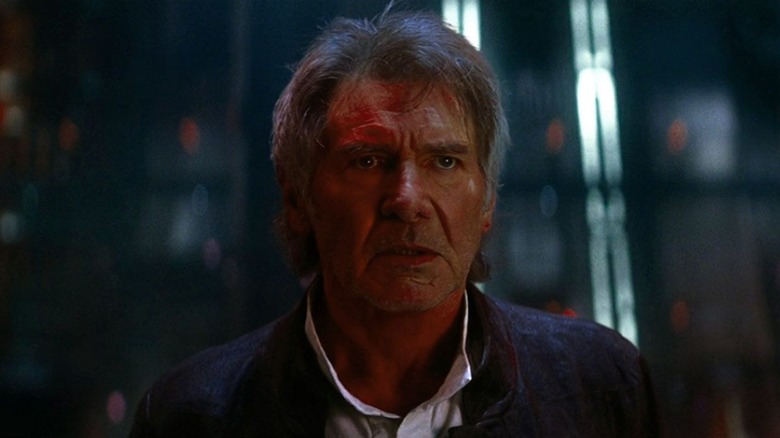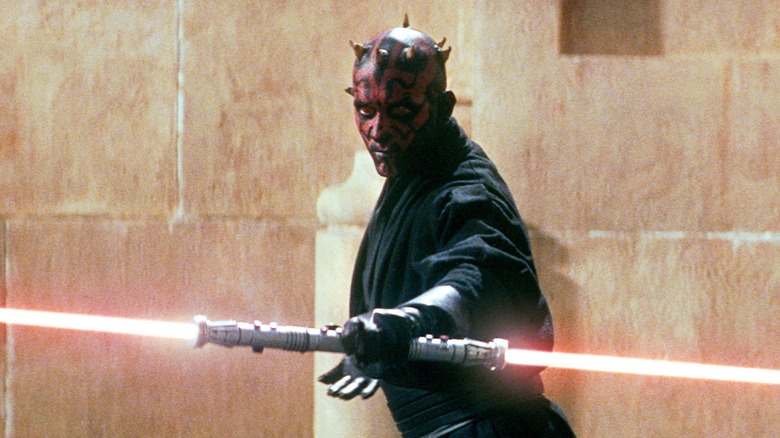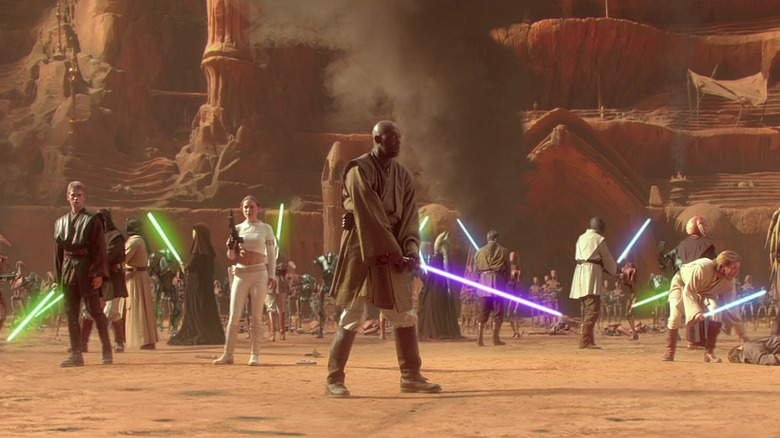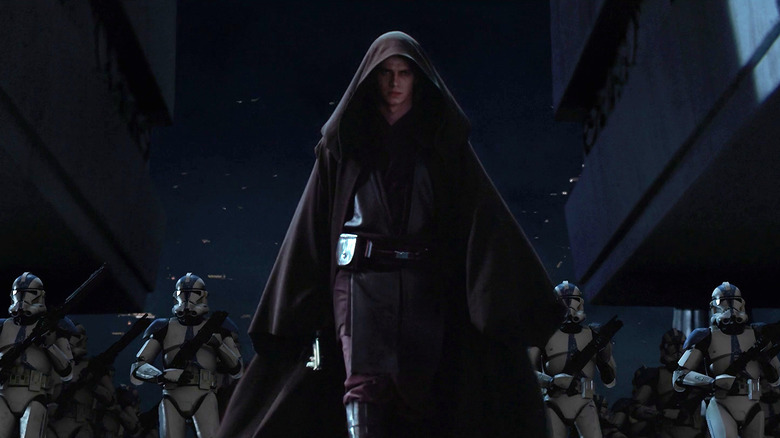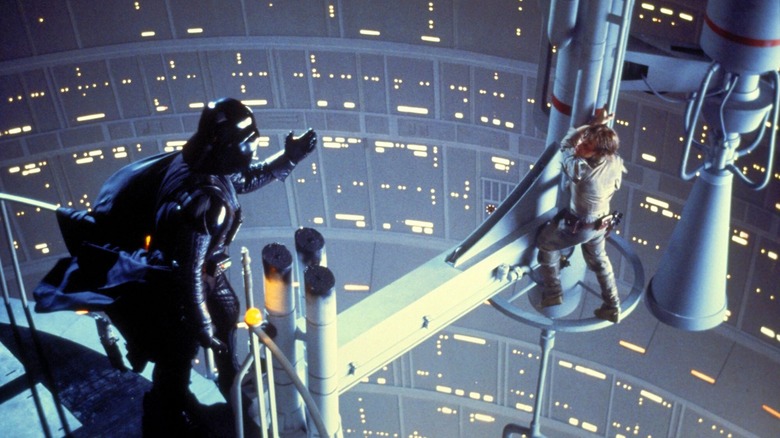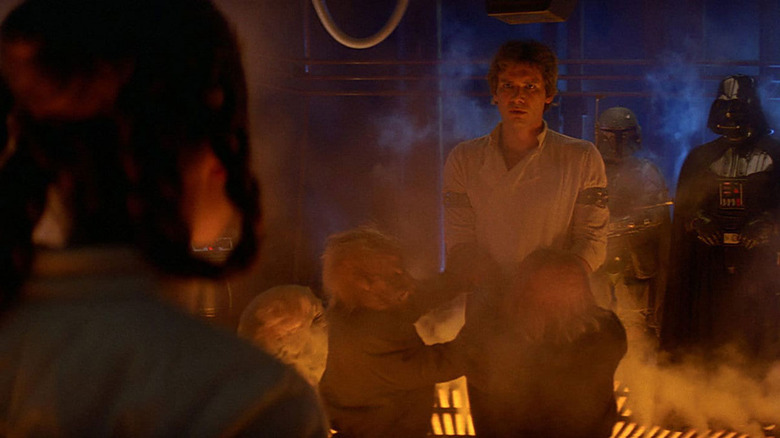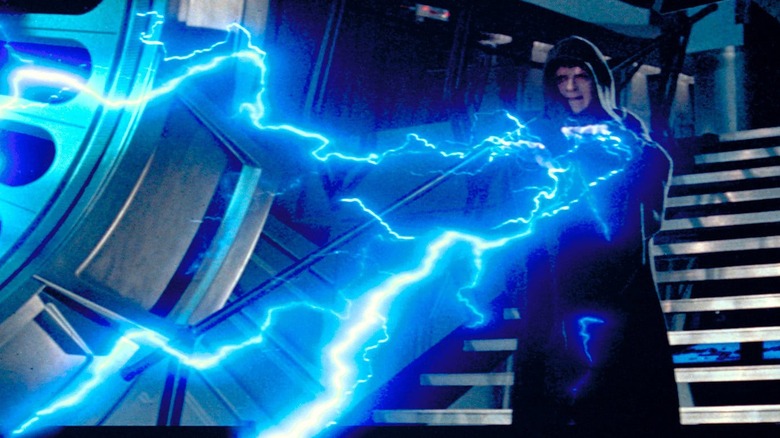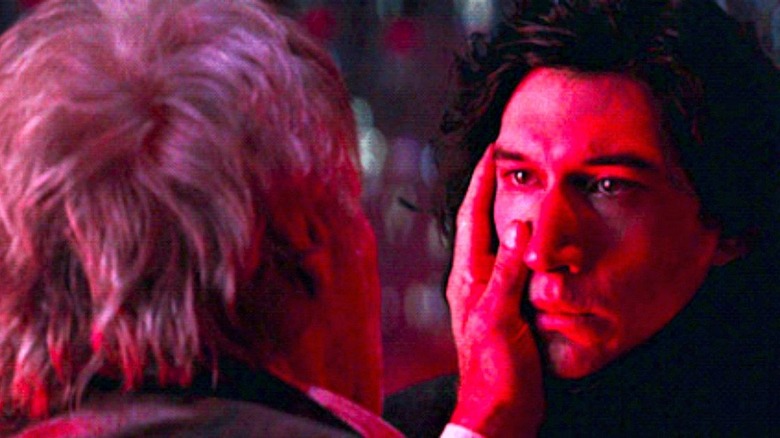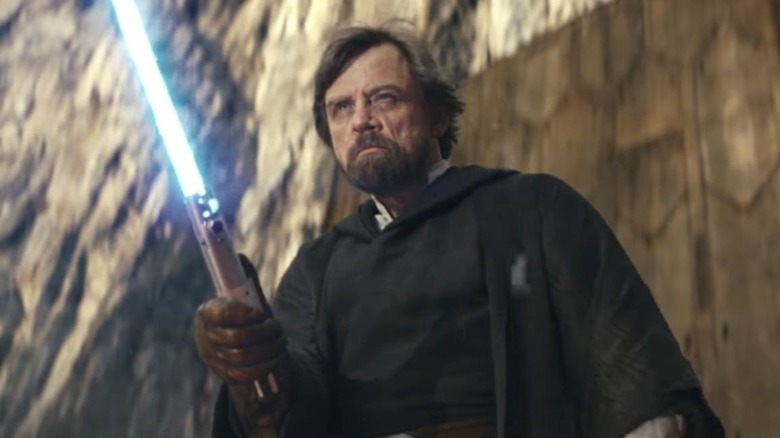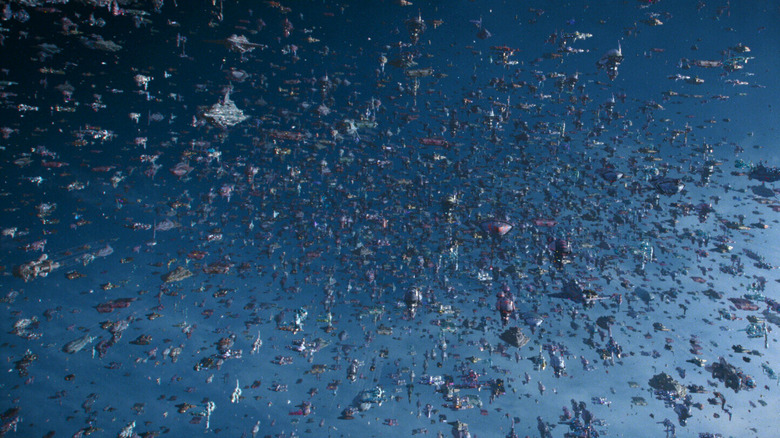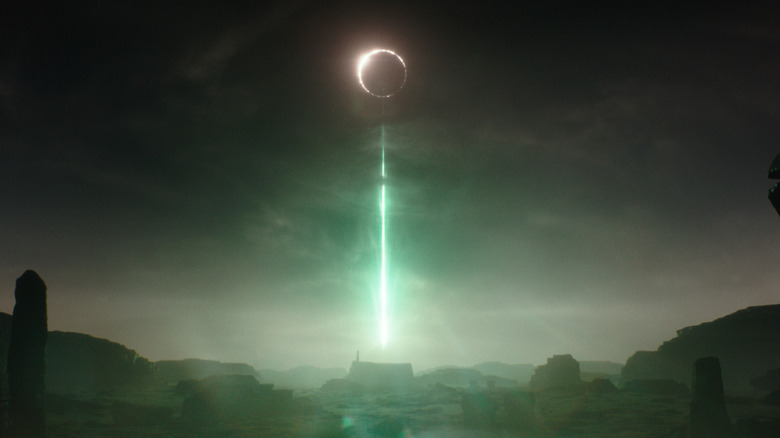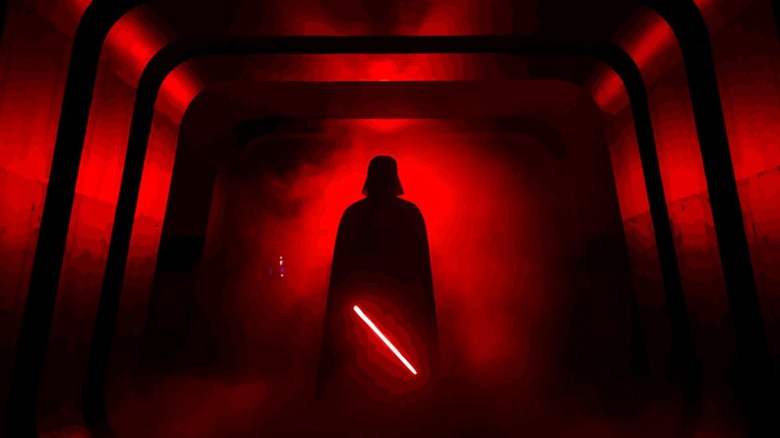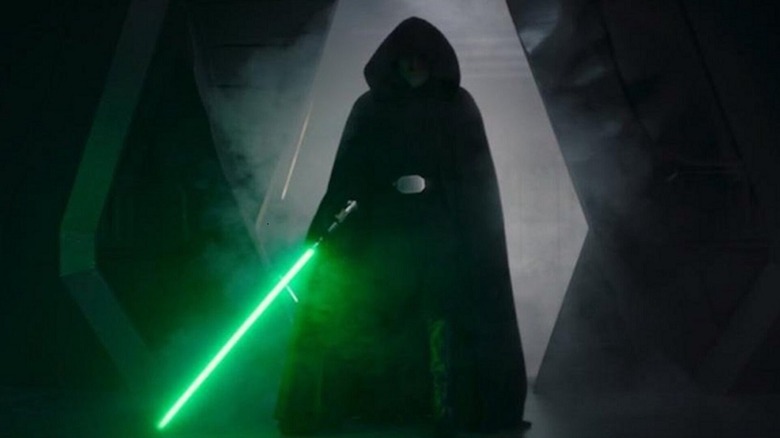Star Wars Moments That Stunned Audiences
With over a dozen films and shows ready and countless more well on the way, Star Wars is massive in both scope and popularity. It's one of the most successful cinematic franchises in history, and that success has been built upon a multitude of jaw-dropping moments that stunned moviegoers the world over.
Some of the moments were small, subtle things, while others were grandiose and epic to behold. They shaped not only the projects they were in but the Star Wars universe as a whole, and have stayed with fans ever after as they fondly reminisce and revisit these scenes again and again.
Unfortunately, there are far too many stunning moments to even try to fit all of them into one article. In fact, "The Empire Strikes Back" alone could fill up every slide on this list, so instead, here are Star Wars moments that stunned audiences from each episode of the Skywalker Saga — and a few beyond.
Episode I: Darth Maul's Duel of the Fates
Many fans have various bones they like to pick with 1999's "Star Wars Episode I: The Phantom Menace," but one moment that even the fractured Star Wars fandom almost universally adores is the Darth Maul's entrance. Accompanied by John Williams' hauntingly beautiful "Duel of the Fates," it was the first time audiences ever got to see a Jedi and Sith battle with the combatants in their prime, and it was a spectacle to behold.
Jedi Master Qui-Gon Jinn and his Padawan Obi-Wan Kenobi return to liberate Naboo and, as the trumpets begin to play, come face-to-face with Darth Maul. Violins join the trumpets but as Maul begins to draw his lightsaber, both stop to make way for a hauntingly hostile choir as the Sith Lord ignites one blade and then another. Star Wars fans had never seen a double-bladed lightsaber before, and theaters erupted.
The moment is executed magnificently. The music, visuals, costume design, timing, and acting all work in perfect unison to create one of the most chill-inducing moments in the entire movie. The fact that it is just the opening portion of one of the best lightsaber duels in the entire saga is just icing on the cake.
Episode II: The Jedi enter the Geonosis Arena
After finishing George Lucas' original trilogy of Star Wars films, many fans longed to see what the vaunted Jedi Order was like in its prime. What were old Ben Kenobi and Yoda like when they were young, and what was it like living in a galaxy with hundreds or thousands of Jedi living throughout the galaxy? Though they received glimpses of it in "The Phantom Menace," moviegoers finally received their answer in "Star Wars Episode II: Attack of the Clones."
After spending much of the film trying to get to the bottom of an attempt to assassinate Senator Padme Amidala, Anakin Skywalker and Obi-Wan Kenobi have been trapped in an arena on the dusty orange planet of Geonosis by Count Dooku and his separatist droid army. Though the two Jedi and the Senator handily save themselves from the animals meant to kill them, it soon becomes clear that they will not escape alive. Then, it happens.
Samuel L Jackson's Jedi master Mace Windu walks up behind Christopher Lee's Count Dooku and ignites his purple lightsaber, and all over the arena stadium, hundreds of Jedi Knights do the same. The visual is awe-inspiring, and the resulting fight sequence does not disappoint. Finally, after all these years, fans got to see the power of the Jedi.
Episode III: Order 66
Not every stunning moment in Star Wars is exciting; some are tragic beyond belief. Driven to the Dark Side by his deep desire to control the fate of his wife, Anakin Skywalker pledges himself to Darth Sidious and marches on the Jedi Temple as Palpatine gleefully commands his clone armies to execute Order 66.
What follows is a perfectly-executed montage of horror as some of the most haunting music that John Williams has ever composed plays over scenes of Jedi across the galaxy being systematically betrayed and destroyed by the Clone soldiers, their friends. Plo Koon is shot down in his starfighter. Ayla Secura is shot in the back on Felucia, and Ki Adi Mundi's senses are seconds too late to save him on Mygeeto.
The Jedi fall, evil wins, and the scene is exactly as heart-wrenching as it should be.
Episode IV: The opening shot
"Star Wars Episode IV: A New Hope," of course, is the film that started it all. It was released to an uproar of popularity, ensuring it would live long in the imagination of people all around the world — and though the massively successful movie was chalk full of stunning, beautiful moments, at the end of the day there's one stunning moment that stands above all the rest.
It's not any portion of the Death Star run. It's not meeting Darth Vader for the first time or seeing him strike down Ben Kenobi. It's the very first moment of Star Wars that fans got to see, the moment that instantly grabbed the world's attention and hasn't let go since. It's the very first shot of the film.
Moments after the opening crawl finishes rolling across the screen against a back drop of stars, the camera pans down to reveal two moons and an iridescent planet below them. A small ship enters stage from the right and flies towards the planet, taking heavy fire — and then a second, much larger ship begins to enter frame and seemingly never stops.
It takes well over 10 seconds for the ship to fully enter the shot, conveying the sheer scale of both the craft and the relentless, monolithic military behind it. The ship is massive, and just with the sheer juxtaposition of size, it's clear that this is the evil Empire and that the Rebellion is hopelessly outmatched.
Episode V: No, I am your father.
It's one of the most famous twists in the history of storytelling, cinematic or otherwise. Luke Skywalker has raced off to the Cloud City of Bespin in an attempt to save his friends from Darth Vader and inadvertently falls into the Sith Lord's trap. After an intense yet hopeless duel, Vader cuts off Luke's hand and traps the young Jedi hopeful. He commands Luke to join him, and after the boy refuses, Vader reveals his greatest secret.
Vader didn't kill Luke's father. "No, I am your father," he says.
It's a moment no one saw coming after watching "A New Hope," and it has been etched into the public consciousness ever since. To those who saw the film in theaters, it cemented "Empire" as their favorite Star Wars film. For the many who came after, it is a moment so famous they can't even remember not knowing it.
Episode V: Han Solo is frozen in carbonite
Despite its intensity, Darth Vader's parental revelation is but one of many hard-hitting, stunning moments in "Star Wars Episode V: The Empire Strikes Back." This is in direct contrast with "A New Hope," an example of classic pulp science fiction adventure. There's drama and tension and excitement, but it's never truly in doubt that the good guys will ultimately win in the end.
When "Empire" was first released, many people in the audience likely expected the same thing — but this time, the good guys didn't win. They lost at Hoth in the film's opening act. They lost at Bespin when Han Solo was frozen in carbonite, and they lost again when Darth Vader cut off Luke Skywalker's hand. In the end, the good guys escaped with tail tucked firmly between legs — but not Han, who seems like he has suffered a fate worse than death.
Audiences knew from the title that the Empire would "Strike Back," but they couldn't have possibly expected that attack to succeed so spectacularly. Because of this, Han's entombment in the carbonite freezing chamber is one of the most poignant moments in the film. The Empire has won, and for the famous smuggler, there will be no escape.
Episode VI: The Emperor Unleashed
The Rebellion is in the midst of a last ditched effort to destroy the Empire forever. Leia Organa leads a ground assault to destroy the Death Star's shield array, while Admiral Ackbar and Lando Calrissian lead the Rebel fleet in the main assault on the space station itself. Meanwhile, Luke Skywalker faces Darth Vader once and for all.
The craziest part is, it seems to be working. Han and Chewie blow the shield generator sky high, and Luke actually manages to defeat his father without giving in to the Dark Side, and as the Rebel ships rush to destroy the Death Star's main reactor, it looks like the Empire's days are over.
Then Palpatine gets out of his chair. The true Dark Lord of the Sith enters the fray, and all hope vanishes in an instant as he unleashes the full power of the Dark Side upon a defenseless Luke Skywalker. Force lightning — something fans didn't yet know was possible — launched from his fingertips and sent the young Jedi writhing in pain to the floor. The full power of Darth Sidious had been unleashed, and Luke seemed powerless to stop it.
Episode VII: The death of a legend
After more than 30 years, the original Star Wars actors were going to finally be back in theaters, with Han Solo set to lead the charge. Played by the legendary Harrison Ford, Han Solo is one of the single most popular characters in the entire franchise, and getting to see him in action again was one of the main selling points of "Star Wars Episode VII: The Force Awakens." But as Luke would say one movie later, "This is not going to go the way you think."
As the film unfolded, fans learned that in between Episodes VI and VII, Han and Leia had indeed been married and had a son named Ben, who Luke trained to become a Jedi Knight. After meeting the First Order's Supreme Leader Snoke, however, Ben had chosen to walk the path of the Dark Side, becoming Kylo Ren. In the film's final act, Han finally caught up to his beloved son, pleading with him to come home.
After a brief, emotional conversation, Kylo Ren asks his father for help. He then lifts his lightsaber, ignites the blade into Han's chest, and lets the body fall, lifeless, into the chasm beneath. Chewbacca and Rey scream in rage, pain, and grief as General Leia Organa feels the loss from across the galaxy. It was a startling end for one of the most iconic characters in the history of motion pictures.
Episode VIII: Luke's final stand
Ever since "Return of the Jedi," fans have longed to see Luke Skywalker onscreen in his prime. Countless books and video games featured Luke as a powerful, full-fledged Jedi Master, and fans wanted few things more than to see it realized on screen in all its glory. When the sequel trilogy was finally announced, hope rose again — but instead, Rian Johnson introduced them to a Luke Skywalker who had grown old and jaded; a Luke Skywalker who had given up.
After driving Ben to the dark side in his hubris, Luke exiled himself to Ahch-To and refuses to train Rey or help the Resistance when she finally finds him. "You think what," he tells her, "I'm going to walk out with a laser sword and face down the whole First Order?" Fans' hopes seemed dashed by that moment until the end of the film, when Luke Skywalker does exactly that.
The First Order has cornered General Leia Organa and the last remnants of the Resistance on the remote salt-planet Crait. With no hope of escape, the Resistance awaits their fate until suddenly, Luke appears and confronts an entire army by himself. Ultimately, it's "just" an illusion that Luke cast from across the galaxy, but fans still got to see their hero in all his glory one last time, and it's still one of the most stunning moments in the saga.
Episode IX: The People's Fleet
"Star Wars Episode IX: The Rise of Skywalker" had a lot of boxes to check in its runtime. It was not only supposed to conclude a trilogy, but also the nine-movie Skywalker Saga as a whole. Though many fans disagree on how well it managed this monumental task, there is one incredible moment that managed to impress almost everybody: the entrance of the Citizen's Fleet.
Also referred to as "the People's" or "Galaxy Fleet," this vast collection of starships from across the galaxy arrived in the nick of time to save Poe Dameron, the Resistance, and the entire galaxy from Darth Sidious' fleet of planet-destroying Star Destroyers. Lando Calrissian arrives with the ships just as the moment seems hopeless, and John Williams scored the moment with the classic opening crawl main Star Wars theme.
What makes the moment so incredible, however, is that the fleet doesn't belong to the New Republic or the Resistance. As one First Order officer puts it: "It's not a navy, sir. It's just ... people." Normal people from across the galaxy banded together to fight evil and oppose tyranny. It's an incredible message that's backed up by one of the most impressive shots in the entire saga, as 16,000 individually rendered starships converge upon the First Order.
Rogue One: The Death Star's first shot
"Rogue One: A Star Wars Story" is unique among the franchise. A prequel that directly leads into "A New Hope," the film tells the story of how the Rebellion discovered the Death Star, and learned its achilles' heel by stealing its blueprint. But forty-five minutes into the feature, fans get their first look at the Death Star's famous super-laser, and the moment is as beautiful and stunning as it is horrifying.
Finally finished, the Empire decides to test the Death Star's weapon by firing upon a single city on the planet of Jedha. The moment is monumental, but instead of playing it as this loud, dramatic event, the actual aligning and firing of the station's laser is surprisingly muted. As Jyn Erso listens to a hologram recording from her father, the shots quietly shift back and forth to the Death Star as her father describes it to her.
Viewers watch in awe as the station moves into position, casts the city in its shadow, and slowly eclipses the sun, destroying the city. The shot is beautiful, with the strange majesty of the cinematography depicting the blast's destruction in wide, gorgeous shots. This contrasts sharply with the genocidal horror inherent in a "Death Star," resulting in a chilling effect that has yet to be matched within the saga.
Rogue One: Darth Vader's hallway stroll
The destruction of Jedha wasn't the last flirtation with horror by "Rogue One," however. In the final moments of the film, after the entire main cast is dead and Scarif has been destroyed, the Rebels attempt to flee with the stolen Death Star plans, but just when they think they're about to succeed, a door jams, a familiar breathing noise sounds, and Darth Vader's lightsaber alights the entire hallway in an eerie red glow.
The rebels do their best, but the end is clear, and sure enough the soldiers fall one by one at the glowing blade of the powerful Sith Lord. The moment is stunning, unexpected, and brilliantly executed. Right when the movie looked like it is over, fans had received its best scene, scored with powerful music and filled with some of the best choreography and action the saga had ever seen.
The Mandalorian: A single X-Wing
Despite many incredible moments throughout the Skywalker Saga films, there's one from the first Star Wars live-action television series that might eclipse them all.
In the Season 2 finale of "The Mandalorian," new fan-favorite characters Din Djarin (the titular "Mandalorian") and little Grogu (affectionately known by fans as "Baby Yoda") are trapped on the bridge of an Imperial cruiser as a battalion of heavily armed and armored droids called "Dark Troopers" are coming to kill them.
Earlier in the episode, Mando had barely managed to defeat one of the battle droids, so there was no way he would be able to survive against dozens more, even with Bo-Katan Kryze, Cara Dune, Fennec Shand, and a third Mandalorian at his side. As the team prepares to make their last stand, however, a lone X-Wing docks in the ship's hangar bay — and one person, clothed in black, emerges from the ship as a calm but powerful piece of music begins to play.
Mando and the others watch from the bridge's screens as the figure ignites a lightsaber and single-handedly destroys every single Dark Trooper on his way to the bridge. When he arrives, he lowers his hood and reveals himself. It's Luke Skywalker, wielding his green lightsaber and wearing the Jedi costume from "Return of the Jedi." At long last, the version of Luke that everybody had longed to see for decades was finally on screen, and it was glorious.
